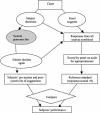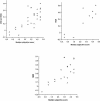Measuring the impact of diagnostic decision support on the quality of clinical decision making: development of a reliable and valid composite score
- PMID: 12925549
- PMCID: PMC264434
- DOI: 10.1197/jamia.M1338
Measuring the impact of diagnostic decision support on the quality of clinical decision making: development of a reliable and valid composite score
Abstract
Objective: Few previous studies evaluating the benefits of diagnostic decision support systems have simultaneously measured changes in diagnostic quality and clinical management prompted by use of the system. This report describes a reliable and valid scoring technique to measure the quality of clinical decision plans in an acute medical setting, where diagnostic decision support tools might prove most useful.
Design: Sets of differential diagnoses and clinical management plans generated by 71 clinicians for six simulated cases, before and after decision support from a Web-based pediatric differential diagnostic tool (ISABEL), were used.
Measurements: A composite quality score was calculated separately for each diagnostic and management plan by considering the appropriateness value of each component diagnostic or management suggestion, a weighted sum of individual suggestion ratings, relevance of the entire plan, and its comprehensiveness. The reliability and validity (face, concurrent, construct, and content) of these two final scores were examined.
Results: Two hundred fifty-two diagnostic and 350 management suggestions were included in the interrater reliability analysis. There was good agreement between raters (intraclass correlation coefficient, 0.79 for diagnoses, and 0.72 for management). No counterintuitive scores were demonstrated on visual inspection of the sets. Content validity was verified by a consultation process with pediatricians. Both scores discriminated adequately between the plans of consultants and medical students and correlated well with clinicians' subjective opinions of overall plan quality (Spearman rho 0.65, p < 0.01). The diagnostic and management scores for each episode showed moderate correlation (r = 0.51).
Conclusion: The scores described can be used as key outcome measures in a larger study to fully assess the value of diagnostic decision aids, such as the ISABEL system.
Figures








Comment in
-
Diagnostic decision support systems: how to determine the gold standard?J Am Med Inform Assoc. 2003 Nov-Dec;10(6):608-10. doi: 10.1197/jamia.M1416. J Am Med Inform Assoc. 2003. PMID: 14613944 Free PMC article. No abstract available.
Similar articles
-
Measuring the quality of diagnostic hypothesis sets for studies of decision support.Stud Health Technol Inform. 1998;52 Pt 2:864-8. Stud Health Technol Inform. 1998. PMID: 10384584
-
Diagnostic omission errors in acute paediatric practice: impact of a reminder system on decision-making.BMC Med Inform Decis Mak. 2006 Nov 6;6:37. doi: 10.1186/1472-6947-6-37. BMC Med Inform Decis Mak. 2006. PMID: 17087835 Free PMC article.
-
The IDEA Assessment Tool: Assessing the Reporting, Diagnostic Reasoning, and Decision-Making Skills Demonstrated in Medical Students' Hospital Admission Notes.Teach Learn Med. 2015;27(2):163-73. doi: 10.1080/10401334.2015.1011654. Teach Learn Med. 2015. PMID: 25893938
-
Identifying reasoning strategies in medical decision making: a methodological guide.J Biomed Inform. 2005 Apr;38(2):154-71. doi: 10.1016/j.jbi.2005.02.001. J Biomed Inform. 2005. PMID: 15797004 Review.
-
APPRAISE-AI Tool for Quantitative Evaluation of AI Studies for Clinical Decision Support.JAMA Netw Open. 2023 Sep 5;6(9):e2335377. doi: 10.1001/jamanetworkopen.2023.35377. JAMA Netw Open. 2023. PMID: 37747733 Free PMC article.
Cited by
-
Assessing the Performance of a New Artificial Intelligence-Driven Diagnostic Support Tool Using Medical Board Exam Simulations: Clinical Vignette Study.JMIR Med Inform. 2021 Nov 30;9(11):e32507. doi: 10.2196/32507. JMIR Med Inform. 2021. PMID: 34672262 Free PMC article.
-
Beyond the threshold: real-time use of evidence in practice.BMC Med Inform Decis Mak. 2013 Apr 15;13:47. doi: 10.1186/1472-6947-13-47. BMC Med Inform Decis Mak. 2013. PMID: 23587225 Free PMC article.
-
Evidence-based decision support for pediatric rheumatology reduces diagnostic errors.Pediatr Rheumatol Online J. 2016 Dec 13;14(1):67. doi: 10.1186/s12969-016-0127-z. Pediatr Rheumatol Online J. 2016. PMID: 27964737 Free PMC article.
-
Can clinical decision support systems be an asset in medical education? An experimental approach.BMC Med Educ. 2023 Aug 11;23(1):570. doi: 10.1186/s12909-023-04568-8. BMC Med Educ. 2023. PMID: 37568144 Free PMC article. Clinical Trial.
-
Improving Team-Based Decision Making Using Data Analytics and Informatics: Protocol for a Collaborative Decision Support Design.JMIR Res Protoc. 2019 Nov 27;8(11):e16047. doi: 10.2196/16047. JMIR Res Protoc. 2019. PMID: 31774412 Free PMC article.
References
-
- Barnett GO, Cimino JJ, Hupp JA, Hoffer EP. DXplain: an evolving diagnostic decision-support system. JAMA. 1987;258:67–74. - PubMed
-
- Miller R, Masarie FE, Myers JD. Quick medical reference (QMR) for diagnostic assistance. MD Comput. 1986;3(5):34–48. - PubMed
-
- Rubeck RF. ILIAD: a medical diagnostic expert system. Teach Learn Med. 1989;1:221–2.
-
- Warner HR, Haug P, Bouhaddou O, et al. ILIAD as an expert consultant to teach differential diagnosis. In: Proc Annu Symp Comput Appl Med Care. 1988:371–6.
Publication types
MeSH terms
LinkOut - more resources
Full Text Sources
Other Literature Sources

